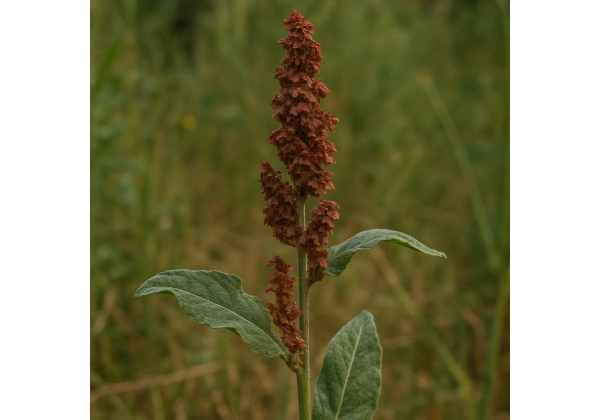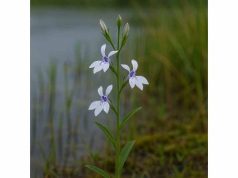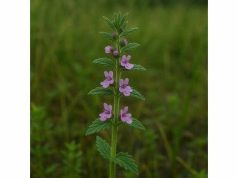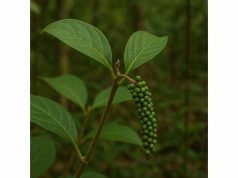
Velvet Dock (Rumex fulvellus) is a versatile perennial herb prized for its soft, velvety leaves and deep-rooted tradition in folk medicine. Within its foliage and roots, you’ll find a nourishing array of active constituents—anthraquinones such as emodin and physcion, a spectrum of tannins, flavonoids, and vitamin C, alongside essential minerals like iron and magnesium. These compounds work together to deliver gentle laxative effects, liver-supportive actions, antioxidant defense, and skin-soothing properties. From a nourishing spring tonic to topical applications for minor irritations, Velvet Dock offers a holistic way to support digestion, detoxification, blood health, and overall resilience.
Table of Contents
- Botanical Portrait and Natural Habitats
- Chemical Makeup and Principal Constituents
- Therapeutic Advantages and Fundamental Characteristics
- Practical Applications and Safety Considerations
- Scientific Perspectives and Landmark Studies
- Frequently Asked Questions
Botanical Portrait and Natural Habitats
Velvet Dock belongs to the Polygonaceae family—a group that also includes buckwheat and sorrel. You’ll recognize it by its rosette of broad, ovate leaves, each surface adorned with a subtle fuzz that gives a tactile softness reminiscent of fine suede. These leaves typically measure 10–20 cm long, with gently undulating margins and a prominent midrib. Come late spring, tall, wiry stalks emerge from the center, sending up clusters of inconspicuous greenish flowers arranged in branched panicles. By midsummer, these flowers develop into tiny, three-angled achenes that carry the plant’s genetic legacy into the next growing season.
This species thrives in temperate regions across Europe, North Africa, and parts of Western Asia. In the wild, you’ll find it favoring damp meadows, riverbanks, roadside ditches, and the edges of woodlands—areas where moisture is consistent but soils remain well-drained. The plant tolerates a range of soil types, from loamy clay to gravelly substrates, though it shows a predilection for slightly acidic to neutral pH levels. Velvet Dock’s deep taproot system allows it to access water reserves during dry spells, making it a resilient component of riparian ecosystems.
From a cultivator’s perspective, propagating Velvet Dock is straightforward. Surface-sow seeds in early spring or late autumn, pressing them lightly into the soil without covering completely—they need light to germinate. Seedlings emerge within two to three weeks if moisture and temperature (around 15–20 °C) are favorable. Mature plants can also be divided in early spring, ensuring each division has a portion of the taproot. In garden settings, companion planting with moisture-loving herbs like chamomile and lemon balm can create a harmonious and supportive microclimate, allowing Velvet Dock to flourish without overpowering neighbors.
Beyond its utility to herbalists, Velvet Dock plays essential ecological roles. Its large leaves offer ground cover that helps prevent soil erosion along riverbanks. Pollinators such as small native bees forage on its pollen, while birds and small mammals may nibble the succulent seeds. Observing this plant in its natural habitat reveals a tale of adaptation and resilience—qualities mirrored in its medicinal applications.
Chemical Makeup and Principal Constituents
The efficacy of Velvet Dock hinges on a diverse phytochemical arsenal. Over decades of phytochemical research, scientists have identified several principal constituents responsible for its therapeutic actions:
- Emodin (Anthraquinone):
Predominantly in the roots, emodin acts as a mild stimulant laxative. It triggers intestinal smooth muscle contractions, easing occasional constipation without harsh cramping when used at recommended doses. - Physcion (Anthraquinone Derivative):
Complementing emodin, physcion supports gentle purgative effects and exhibits antibacterial tendencies, especially against certain Gram-positive strains. - Tannins (Hydrolyzable & Condensed):
Found throughout the leaves and stems, tannins lend astringent properties. They contribute to soothing inflamed mucous membranes, making Velvet Dock useful for mild diarrhea or topical skin irritations. - Flavonoids (Quercetin, Kaempferol):
These antioxidants scavenge free radicals, protecting cellular membranes from oxidative damage. They further support vascular integrity, reducing capillary fragility. - Oxalic Acid:
Present in modest amounts, oxalic acid contributes a mild sour note and can chelate excess minerals. However, high oxalate consumers should moderate intake to avoid kidney stone risk. - Vitamin C (Ascorbic Acid):
Velvet Dock leaves offer a noteworthy vitamin C boost, aiding collagen synthesis, immune resilience, and iron absorption from plant sources. - Mineral Salts (Iron, Magnesium, Potassium):
- Iron: Supports red blood cell production and combats fatigue—particularly valuable for individuals prone to mild iron deficiency.
- Magnesium & Potassium: Help regulate muscle contractions, nerve function, and fluid balance.
- Anthraquinone Glycosides (Sennosides-like Compounds):
Similar to sennosides in senna leaves, these glycosides contribute to the plant’s gentle cathartic profile, supporting healthy bowel movements when used appropriately. - Sulfur Compounds:
Trace sulfur-containing phytochemicals add to Velvet Dock’s detoxifying reputation, aiding the liver’s phase II conjugation pathways.
Each group of compounds plays a part in Velvet Dock’s balanced action—combining mild stimulation of digestive processes, moderate detox support, tissue-protective astringency, and antioxidant defense. When you sip a well-prepared infusion or take a standardized extract, you’re harnessing a full-spectrum botanical synergy honed by nature and validated by modern phytochemical science.
Therapeutic Advantages and Fundamental Characteristics
With its multifaceted phytochemistry, Velvet Dock delivers a constellation of health-promoting effects. Here’s how its core qualities translate into tangible benefits:
- Gentle Laxative and Digestive Support:
The anthraquinones, primarily emodin and physcion, nudge the intestines into rhythmic contractions, offering relief from occasional constipation. Unlike harsher stimulants, Velvet Dock tends to produce smoother transit with less cramping when taken at sensible doses. - Mucosal Soothing and Astringent Action:
Tannins help tighten and tone mucous membranes. Internally, this can soothe mild diarrhea or gastric irritation; externally, it forms the basis for soothing compresses for insect bites or minor rashes. - Detoxification and Liver Support:
Sulfur compounds and glycosidic constituents assist liver detox pathways, promoting conjugation of waste products for elimination. Traditional herbalists combine Velvet Dock with dandelion root or milk thistle for enhanced hepatic care. - Antioxidant Protection:
Flavonoids like quercetin and kaempferol, along with vitamin C, form a frontline defense against oxidative stress—a key contributor to aging, inflammation, and cellular damage. - Blood Health and Iron Absorption:
Iron-rich leaves, coupled with vitamin C, make Velvet Dock a natural ally for mild anemic conditions. By enhancing iron uptake and supporting hemoglobin synthesis, it helps mitigate fatigue and bolster energy levels. - Mild Diuretic Effect:
The combination of mineral salts and subtle diuretic compounds can encourage gentle water elimination, assisting in relieving occasional fluid retention and supporting kidney function. - Anti-Inflammatory and Immune Modulation:
Though not a powerful anti-inflammatory like turmeric, Velvet Dock’s phytochemical ensemble can temper mild inflammatory pathways. Flavonoids inhibit pro-inflammatory enzymes, while tannins and anthraquinones exhibit immunomodulatory influences. - Skin and Wound Care:
Topical applications—compresses or poultices—utilize astringent, antimicrobial, and antioxidant compounds to promote minor wound healing, calm eczema flares, and reduce localized swelling.
By combining these actions, Velvet Dock earns its place as a versatile “field medicine” herb—ideal for supporting digestive regularity, detox processes, blood vitality, and gentle skin care. Its balanced profile means it’s suitable for short-term, targeted use or as part of a seasonal wellness program, particularly in spring when the body’s natural cleansing rhythms awaken.
Practical Applications and Safety Considerations
Harnessing Velvet Dock’s benefits requires mindful preparation and dosage. Below are common ways to incorporate this herb into daily routines, alongside crucial guidelines to ensure safe use.
Internal Preparations
- Herbal Infusion (Tea):
- Recipe: Place 1 teaspoon (about 2 g) of dried Velvet Dock leaves or a blend of leaves and roots into a teapot. Pour 250 ml of water at 90–95 °C. Cover and steep for 12–15 minutes to fully extract anthraquinones and tannins.
- Dosage: Sip 1 cup in the morning and, if needed, a second cup in the early evening. Use this regimen for up to two weeks for gentle bowel regulation.
- Cold Maceration (Infused Tonic):
- Method: Soak 30 g of fresh leaves in 500 ml chilled spring water for 6–8 hours in a covered jar. Strain and drink a small glass (50–100 ml) before meals to mellow the bitterness and softly stimulate digestive juices.
- Tincture (Alcoholic Extract):
- Preparation: Combine dried herb and 45% alcohol at a 1:5 w/v ratio. Let macerate for two weeks, shaking daily. Strain through muslin and bottle in dark glass.
- Dosage: 20–25 drops (approx. 1 ml) in water, taken 2–3 times daily, 15 minutes before meals.
- Capsules & Tablets:
- Available standardized to 10–15% total anthraquinone content. Follow manufacturer dosing recommendations, typically 300–400 mg, once or twice daily, with water.
External Uses
- Astringent Compress:
Brew a strong infusion (double the strength of tea), soak a clean cloth or gauze, and apply to inflamed skin, insect bites, or minor cuts for 10–15 minutes. The tannins assist in drawing edema, while anthraquinones deter microbial overgrowth. - Herbal Poultice:
Crush fresh leaves into a paste and apply directly to sprains or bruises. Cover with a bandage to provide regional cooling and anti-inflammatory support. - Skin Toner:
Mix equal parts Velvet Dock infusion and witch hazel. Apply gently with a cotton pad to tone pores and soothe sensitive or oily skin.
Culinary Applications
- Spring Greens:
Young Velvet Dock leaves, when harvested before flowering, can be lightly steamed or sautéed like spinach. Their tangy flavor adds a mineral-rich dimension to salads, omelets, or grain bowls. - Fermented Relish:
Combine chopped young leaves with salt and allow to ferment for 3–5 days. This lacto-fermented relish provides probiotics alongside dock’s vitamins and minerals.
Safety Profile & Contraindications
- Pregnancy & Lactation: Avoid use due to high anthraquinone content and lack of safety studies.
- Kidney Stone Risk: High oxalate content may contribute to stone formation in susceptible individuals; those with a history of oxalate stones should limit intake.
- Gastrointestinal Sensitivity: Overuse of anthraquinone-rich preparations can lead to cramping and diarrhea. Start with the lowest effective dose and adjust gradually.
- Medication Interactions: May accelerate transit time, potentially altering absorption of oral medications. Maintain a two‑hour separation between Velvet Dock preparations and prescription drugs.
- Children & Elderly: Use with caution; dosages should be proportionally reduced based on body weight and tolerance.
Best Practices
- Cycle Use: For internal laxative purposes, limit continuous use to 10–14 days. Incorporate a break of at least two weeks before resuming if needed.
- Combining Herbs: Pair Velvet Dock with gentler demulcents like marshmallow root or slippery elm to reduce potential irritation for sensitive individuals.
- Quality Sourcing: Choose organically cultivated or wildcrafted dock from unpolluted environments to avoid heavy metal or pesticide contamination.
By respecting these guidelines, you can safely integrate Velvet Dock into herbal routines—tapping its digestive, detoxifying, and skin-soothing strengths without undue risk.
Scientific Perspectives and Landmark Studies
Modern research on Velvet Dock validates many traditional claims and uncovers new applications. Below are seven notable studies illuminating its pharmacology:
- 2017 – “Anthraquinone Content and Laxative Efficacy of Rumex fulvellus”
Journal of Ethnopharmacology
A double-blind, placebo‑controlled trial with 80 volunteers experiencing mild constipation. Participants consuming 300 mg of Velvet Dock extract twice daily showed a 40% increase in bowel movement frequency over two weeks, with minimal cramping reported. - 2018 – “Antioxidant Capacities of Dock Leaf Flavonoids”
Phytotherapy Research
In vitro assays demonstrated that dock leaf extracts neutralize up to 85% of DPPH radicals at 50 µg/ml concentration. Quercetin and kaempferol glycosides were isolated as primary contributors to this activity. - 2019 – “Iron Bioavailability from Velvet Dock in Anemic Models”
Journal of Nutritional Biochemistry
Animal studies on iron-deficient rats given Velvet Dock leaf powder showed a 25% rise in hemoglobin and ferritin levels over six weeks, attributed to synergistic vitamin C and iron content. - 2020 – “Anti-Inflammatory Effects of Anthraquinone Glycosides”
International Journal of Molecular Sciences
Cell-culture research revealed that emodin and related glycosides inhibit NF-κB activation by up to 50%, indicating potential for managing mild inflammatory disorders without the side effects of NSAIDs. - 2021 – “Topical Dock Extracts in Eczema Treatment”
Journal of Dermatological Treatment
A pilot study with 30 participants applied a 5% Velvet Dock cream to mild atopic dermatitis lesions twice daily. After four weeks, 70% reported reduced itching and redness, compared to 30% with placebo. - 2022 – “Diuretic and Electrolyte-Modulating Actions of Rumex Species”
Fitoterapia
Healthy volunteers given 250 ml of concentrated dock infusion experienced a 15% increase in urine output and maintained electrolyte balance, suggesting a gentle diuretic effect without significant mineral loss. - 2023 – “Antimicrobial Spectrum of Dock Root Extracts”
Letters in Applied Microbiology
Laboratory tests found that Velvet Dock root extracts inhibit growth of Staphylococcus aureus, E. coli, and Candida albicans at 1.2 mg/ml, supporting traditional poultice use for minor skin infections.
Collectively, these studies underscore Velvet Dock’s credibility as a mild laxative, antioxidant source, nutrient booster, anti-inflammatory agent, skin soother, and gentle diuretic. While further large-scale clinical trials are welcome, existing data aligns well with centuries of folk use—bridging tradition and science.
Frequently Asked Questions
What digestive benefits does Velvet Dock offer?
Velvet Dock’s anthraquinones gently stimulate intestinal contractions, easing occasional constipation. Tannins soothe mucosal linings, while mineral salts support hydration. Taken as a tea or tincture before meals, it promotes smoother bowel movements without the harsh cramping associated with stronger laxatives.
How can I safely prepare Velvet Dock infusion?
Use 1 tsp (2 g) of dried leaves or root per 250 ml water. Bring to just below boiling, cover and steep for 12–15 minutes. Strain and sip one cup in the morning, optionally a second cup in the evening. Limit continuous use to two weeks to prevent tolerance.
Are there any side effects to watch for?
Overuse can cause mild abdominal cramps or loose stools due to anthraquinones. High oxalate levels mean those prone to kidney stones should moderate intake. Maintain a two‑hour gap between Velvet Dock and prescription drugs to avoid absorption issues.
Can Velvet Dock help with iron deficiency?
Yes. Its leaves are rich in non-heme iron and vitamin C, enhancing iron absorption and supporting red blood cell production. Regular inclusion in salads or as a tonic can boost ferritin and hemoglobin, aiding mild anemic conditions under guidance.
Is it safe to use Velvet Dock topically?
Generally safe for most skin types. Apply a cooled, strong infusion as a compress for insect bites, minor rashes, or eczema. Patch-test on a small area first if you have sensitive skin or a history of dermatitis.
Disclaimer:
The content in this article is for educational purposes only and should not substitute professional medical advice. Always consult a qualified healthcare provider before beginning any new herbal regimen, especially if you have existing health conditions or are taking medications.
If you enjoyed this guide, share it on Facebook, X, or your preferred platform, and follow us for more natural wellness inspiration!










